Last Updated on April 24, 2024 by Dennis
Galaxy 10K – Can you believe the hype?
Galaxy 10K launched on WarriorPlus yesterday, April 23. You’ve probably already seen promotional Emails in your inbox.
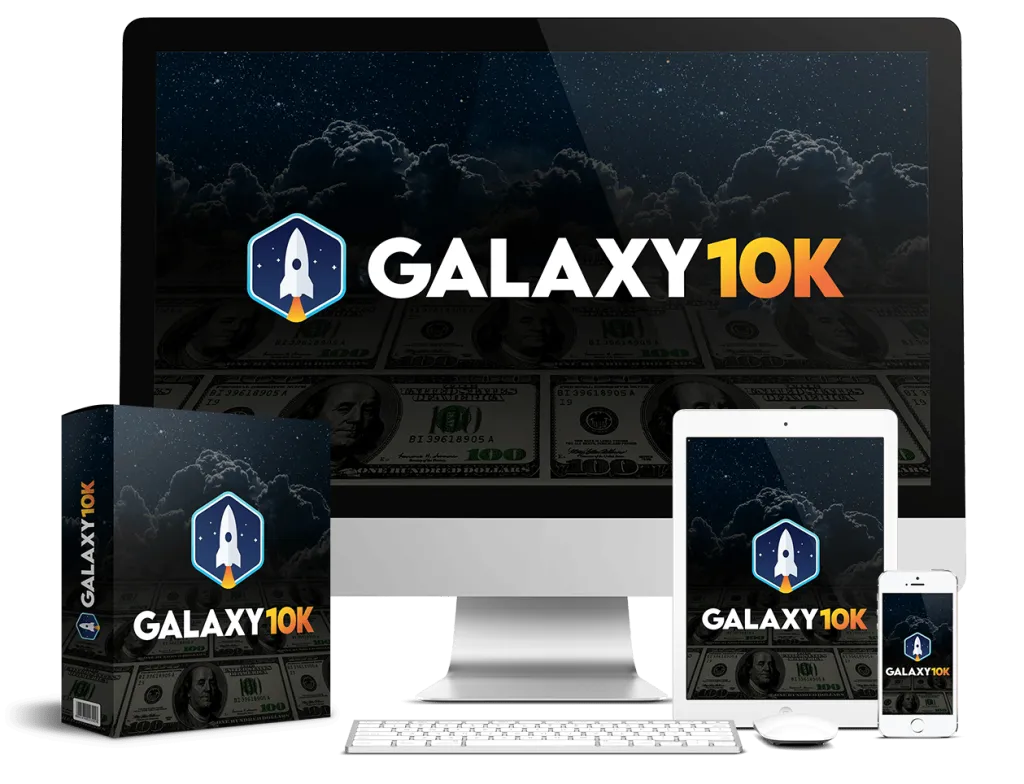
Hopefully, you’ve resisted temptation and held on to your money. If not, then….well, read on anyway.
When I looked at the sales page for Galaxy 10K, I immediately saw some red flags.
Let’s take a look at what I saw and how you can avoid getting ripped off in the future.
The Sales Page
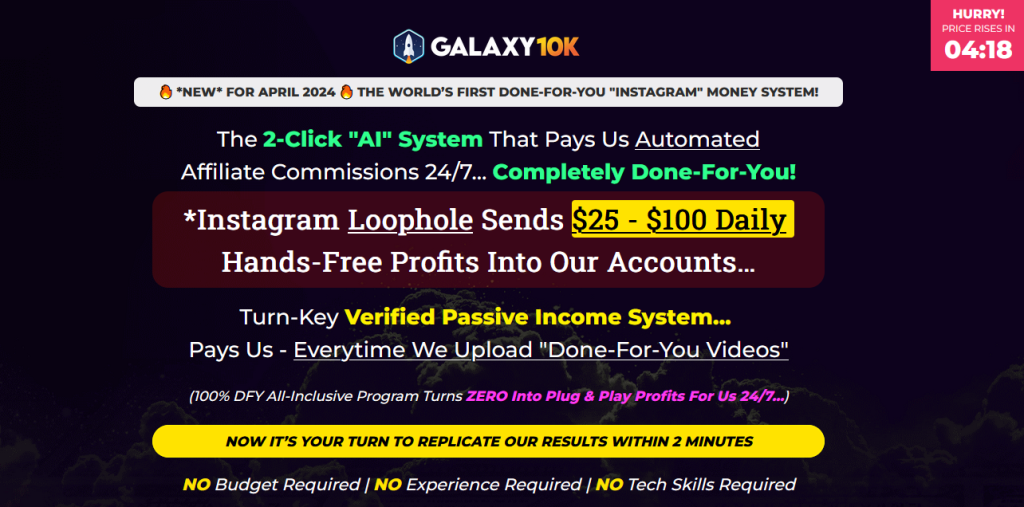
Starting at the top.
We see a countdown timer.
This is to entice you to buy before the timer runs out. Many times, I’ve seen timers that reset every time that you view the page. This one is a true timer and the price is indeed increasing every 60 minutes – by $0.01. Yes, a penny.
If you knew that was the case, would the timer still make it more likely that you would buy? In too many cases, the answer is yes. So, be aware of fake timers and understand that even true timers can move you closer to making a purchase.
Moving down the page, we don’t see anything really concerning until we get to..
Loophole
- “Intagram Loophole Sends $25 – $100 Daily Hands Free Directly Into Our Accounts”
Anytime you see the word “Loophole” a warning bell should sound off in your head. If the product is exploiting a loophole, which is entirely possible, it will work for a few people. But when hundreds of people start to abuse the loophole, the company, in this case, Instagram, will work to close it.
Many times, the product creator will use the loophole and make buku bucks until they see the loophole closing. At that point, they “share” the loophole with you and profit from you purchasing their product.
Think about this. Galaxy 10K has already made over 250 sales and could easily surpass 500 or 1,000 sales. Let’s say he makes 1,000 sales for the following calculations. RIght now, the average sale is $34.81, let’s say $35. Of that $35 the vendor needs to share 50% with his affiliates plus a small fee to WarriorPlus and Paypal and he is offering over $3,000 in affiliate bonuses. So half of $35 equals $17.50, minus fees, leaves the vendor about $16 per sale. $16 X 1,000 = $16,000. Subract the $3,000 in affiliate bonuses and we have only $13,000.
Not a bad sum. But according to the sales page, the vendor is making over $4,000 per week using Galaxy 10K!
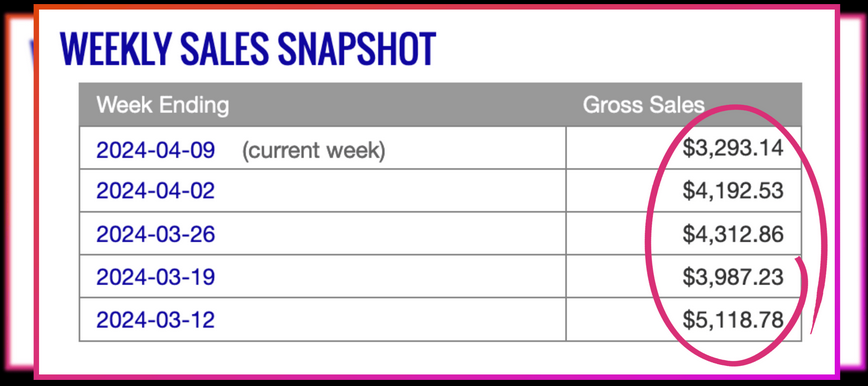
So, in 4 weeks, he says he makes more using Galaxy 10K than we calculate he will make selling Galaxy 10K. It really doesn’t make much sense, especially if we think that the loophole will close when those 1,000 buyers start using it. Why not keep this secret loophole to yourself and make $16,000 per month, every month, instead of $13,000 one time?
The answer is, either the income claims are bogus or the loophole is closing anyway and will not be effective going forward.
It’s Your Turn
“Now It’s Your Turn To Replicate Our Results in 2 Minutes”
That’s what this whole Galaxy 10K product is all about. Replicating the vendor’s results.
But in 2 MINUTES?
Unless you’ve already got a huge following on Instagram, you’re going to have to build up that following before you can start making any kind of consistent money. And as we discussed previously, by the time you do that, the loophole will likely be closed.
First 25 Only??
Moving further down the page, not too much further, mind you, we see this special offer for the the first 25 only.

So, for $9.95 you can Unlock Access to 2 Billion Additional Premium Buyers. But this offer is only available to the first 25 only.
I take that as the first 25 buyers. But after 250+ sales, this is still available. Hmmm.
Is this false scarcity? Is the vendor trying to activate your FOMO (fear of missing out) and get you to buy? Yes.
Or, maybe, the vendor meant the first 25 days, or maybe, the first 25 years, or even until the first 25 people that actually make money with Galaxy 10K.
I don’t know. But this smells kind of funky.
Now, limiting the number of products or bonuses that are available IS a good marketing option. But, I draw the line when it’s fake scarcity like this.
Speaking of false scarcity, here’s another example. This time a free bonus.

This Special Exclusive – The First 50 Customers get Access.
Yeah. Right.
The status bar at the bottom shows that there are still 12/50 Bonuses Remaining even though over 250 people have purchased.
Interestingly, I took this picture about a half hour before Galaxy 10K launched yesterday.

Yep. There were only 12 out of 50 bonuses remaining before the launch, too.
Something is broken. And I really doubt it’s the status bar.
Testimonials
According to the sales page, Galaxy 10K was given to a group of beta testers. And wouldn’t you know it, every one of the beta testers made money in 7 days. That sounds a bit fishy to me, and on further investigation, it is.
Let’s take a closer look at this testimonial.

Making $263.54 in commissions in the first week of using Galaxy 10K would certainly make me happy.
Now, Jessie may be making $263.54 a week, but not from Galaxy 10K.
I grabbed Jessie’s image, did a facial search on Google and I found the same image on 72 different websites. A lot of the images were used in testimonials, just like on Galaxy 10K. For instance, I found this testimonial at https://bloomsleepandairway.com/happy-clients/. Check it out for yourself.

Here, her name is Mary Huston. I’m sure that if I looked, I could find her image for sale at iStock Photos, PhotoDune, Pixabay or any of a number of other stock image sites.
So, if the image isn’t real, is the testimony real? Are any of the testimonials real?
Who is the Vendor, Glynn Kosky?
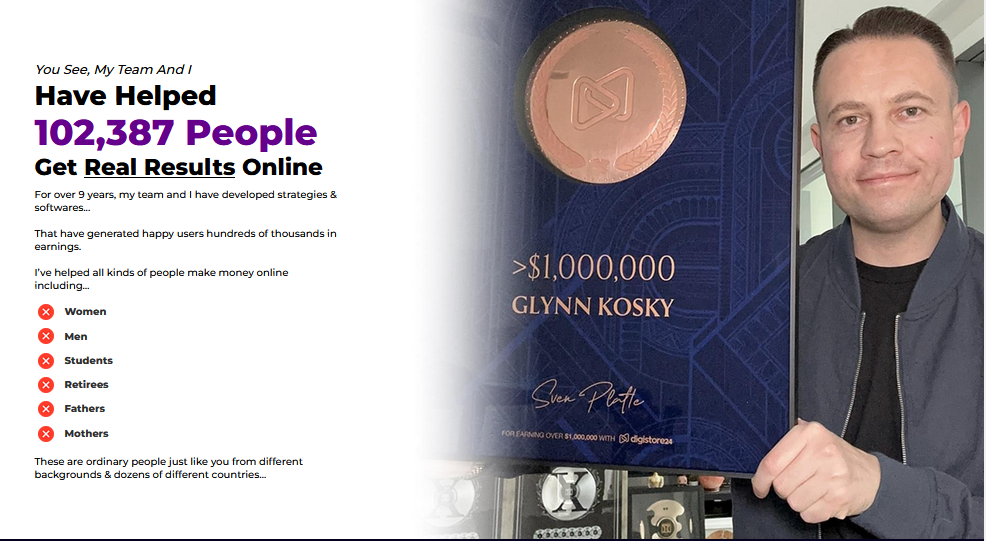
Positives:
Glynn’s been online for many years and is an excellent salesman and marketer.
He doesn’t hide behind a company name. He uses his own images and his own name in his marketing.
He is an effective copywriter and his sales pages bring in the sales.
His products sell and he offers good bonuses to his affiliates, so we see a lot of affiliates jumping on to promote.
Negatives:
Galaxy 10K is his 6th product launch in the last 3 months. So, he’s launching a new product every 2 weeks or so.
He is a master at keeping below the magical 10% refund rate on WarriorPlus.
Here are the stats on his latest products:

As you can see, all of his product launches made over 500 sales, which confirms that his sales pages contain good, compelling copy.
He’s launched 6 products online in the last 12 weeks. That means he is launching a new product every 2 weeks.
How can someone do that?
In order to do that, the vendor either needs to
- Work with someone that actually developed the product
- Put together a product similar to another product that they have
- Throw something together and hope for the best
Glynn has been in this business long enough to know that the third option is really not an option.
So, I think that he most likely uses one of the first 2 options or a combination of the two.
Now, let’s look at the refund rate of the non-free products. We’ve got a 4%, a 7%, an 8%, a 9% and a 10% refund rate on those 5 products. I ignored the data from Galaxy 10K, because it just launched and the 4% is from a product that only launched 2 weeks ago. I would expect that number to go up as we approach the 30 refund period. Compare that to the refund rate of the top 50 products on WarriorPlus, of only 2.86%.
Now, some refunds are expected. But to be 3 or more times the average refund rate is a big red flag.
So, what does the high refund rate mean?
Either that the products or the product support is worse than average or that the products don’t do what is promised on the sales page or that the product won’t work without buying more. I haven’t bought Galaxy 10K, so I can’t say with certainty, but I’m sure that Galaxy 10K will fall into one of those buckets and will also have refund rates approaching 10%.
What Can You Do?
Avoid Serial Launchers – Vendors that launch products more often than 1 per month should be avoided. Think about it. If a vendor is launching a product every 2 weeks (like Glynn) how can he research and test the product prior to launch and how can he possibly provide adequate support after the sale? Go to WarriorPlus.com, go to the dashboard, then click on Affiliates and then offers. Type the name of the vendor in the search bar and you’ll get a listing of his products, with data. Like this.
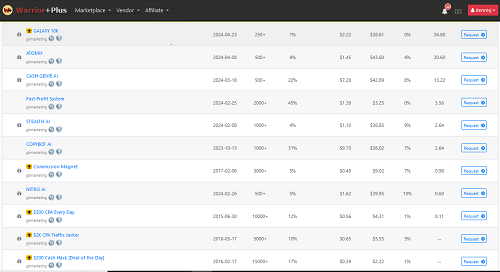
Watch Out For False Scarcity – Although I don’t think it’s ethical, it shouldn’t on its own be a show stopper. Just be aware that it’s there and don’t fall for it.
Beware Sales Pages That Don’t Tell You What You’re Getting – There are a few instances where this is appropriate. Like when a vendor is unveiling a new traffic source. But in most cases, you should know what you’re getting before you spend your money.
Watch Out For Overly Hypey Sales Pages – Before you buy, pause. Try to figure out what it was on the sales page that made you want to get your wallet out. If it was hype on the sales page, you’ll be able to identify it and make a more informed purchasing decision. Even more important, you’ll learn what words and phrases push your buttons.
Look for Reputable Vendors and Products – It’s difficult without a lot of trial and error…and cost, to learn which vendors are responsible, honest and helpful. One such vendor is Tim Ikels. You can get to know him and learn from him by clicking here to get his free course on getting traffic, Traffic Endgame.